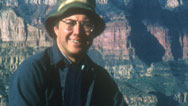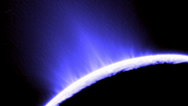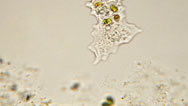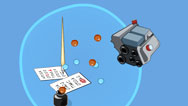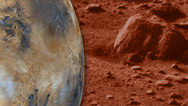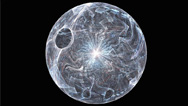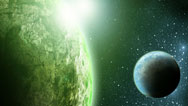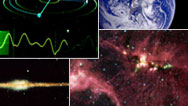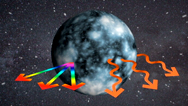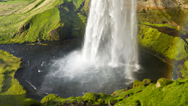
Finding Life Beyond Earth
Scientists are on the verge of answering one of the greatest questions in history: Are we alone? Airing August 8, 2012 at 9 pm on PBS Aired August 8, 2012 on PBS
- Originally aired 10.19.11
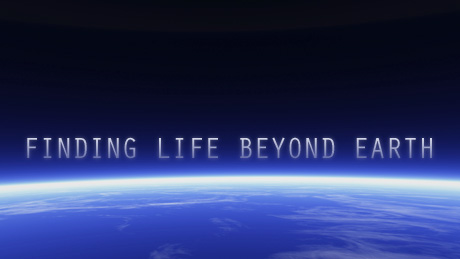
Program Description
Transcript
FINDING LIFE BEYOND EARTH: ARE WE ALONE?
PBS Airdate: October 19, 2011
NARRATOR: Is Earth the only planet of its kind in the universe, or is there somewhere else like this out there? Is there life beyond Earth?
The search for alien life is one of humankind's greatest technological challenges. And scientists are seeking new ways to find answers.
JIM GREEN (Director, Planetary Science Division, NASA): We're pushing the boundary of information of where life can exist, past the earth and out into the solar system.
NARRATOR: Leading the search are sophisticated telescopes that scan the sky and an armada of robotic probes exploring the outer reaches of our solar system, all revealing the planets, moons, asteroids and comets like never before.
AMY MAINZER: We can go places and see things that there's no other way we could've ever seen.
NARRATOR: The search reveals evidence of strange and unexpected worlds, places with lakes, storms and rain; violent places driven by powerful forces deep underground; worlds that may have hidden oceans, hundreds of millions of miles from the heat of the sun.
JIM GREEN: The pace of discovery, just in the last couple of years, is just mindboggling.
NARRATOR: New missions are helping to unlock the mysteries of what makes a planet habitable, raising the question of whether the building blocks of life are more prevalent than previously imagined, not just in our own solar system, but possibly throughout our galaxy.
GEOFF MARCY (Astronomer, University of California, Berkeley): We now have, for the first time in human history, definite planets out there, among the stars, that remind us of home.
NARRATOR: Finding Life Beyond Earth, up now on NOVA.
After a seven-year, two-billion-mile voyage, the spacecraft Cassini enters orbit around Saturn. Cassini heads towards the largest of Saturn's 62 moons, Titan.
Bigger than the planet Mercury, Titan is hidden by a thick orange haze. No one has ever seen its surface.
But a small probe named Huygens, released by Cassini, is about to change everything. This mission will challenge long held notions of where life could exist beyond Earth.
These are the actual images Huygens takes, as it breaks through the clouds and haze. Titan is a land of mountains and valleys, a place that looks surprisingly like Earth. Then, images reveal something no one expects: the surface is littered with smooth rocks, the type normally found in riverbeds on Earth.
CHRIS MCKAY (Astrobiologist, NASA Ames Research Center): My response was shock. We look out on the surface, and we see what looks like a desert, and, at the same time, the data from the probe told us that the ground around the site was wet.
NARRATOR: Hundreds of miles overhead, Cassini's radar sweeps the surface. The images show a landscape covered with what appear to be hundreds of lakes. This one covers an area of 6,000 square miles, about the size of Lake Ontario, one of the Great Lakes. It's a surprising discovery.
CHRIS MCKAY: It's the only world other than the earth that has a liquid on its surface.
NARRATOR: But what exactly is this liquid? Titan is minus-290 degrees Fahrenheit. If it's water, it should be frozen solid.
Then, one of Cassini's instruments analyzes the infrared light reflected off the lakes. The readings are consistent, not with water, but with liquid methane and ethane, substances that, on Earth, are volatile, flammable gases.
The data from Cassini are so detailed, scientists can imagine what it would be like to stand on this cold, distant world.
CHRIS MCKAY: Standing on the surface of Titan, you see Saturn just sitting there in the sky, big, huge stationary object, almost like a door to another dimension.
Here we see lakes, lakes of liquid methane. And in the horizon we see mountains. These are mountains made of ice, made of water ice, frozen so hard that it acts like rocks. And the features that we see in them are carved by the liquid methane that's forming these lakes.
Looking across the horizon on Titan, you might see a thunderstorm or a range of thunderstorms coming at you. We see rain coming down. It's not drops like we're familiar with on Earth; this is methane, instead of water. It falls much more slowly, due to the low gravity, and the drops are bigger.
NARRATOR: So what are the implications of finding a liquid flowing on Titan's surface, for a scientist like Chris McKay?
CHRIS MCKAY: Liquid seems to be the key to life, so maybe there's life in that liquid on Titan: little things, swimming in liquid methane, and being quite happy at these low, cold temperatures.
NARRATOR: There is no evidence that living things like microbes exist in these lakes. But if such evidence were found here, it would fundamentally change perceptions about life beyond Earth. If life could evolve on worlds as drastically different as the earth and Titan, then perhaps life could evolve in many other ways, on many different worlds.
NASA's Director of Planetary science is Jim Green.
JIM GREEN: One of the questions that we all want to know, I think, deep down inside, is: "Are we alone?" I mean, that's really fundamental.
NARRATOR: Jim is at the forefront of a global effort to understand whether the conditions for life exist beyond our planet.
JIM GREEN: We're pushing the boundary of information of where life can exist, past the earth and out into the solar system.
NARRATOR: So, where in our solar system could life potentially exist? Heading out from the sun, the first planet is Mercury. It's an extremely hostile environment.
In March 2011, NASA's Messenger probe becomes the first spacecraft to orbit this small ball of rock and iron.
These are some of the first images sent back.
Three times closer to the sun than Earth is, Mercury bakes in 800-degree heat on its side facing the sun, while on the night side, temperatures plummet to minus-290. Mercury is the ultimate desert world. Life of any kind here seems unlikely.
Mercury's closest neighbor, Venus, is almost as hostile. Though nearly twice as far from the sun, temperatures here exceed 880 degrees. Decades of observations have revealed a planet shrouded in carbon dioxide and toxic clouds of sulfuric acid.
These radar images reveal thousands of ancient volcanoes, on a surface hot enough to melt lead. And with an atmospheric pressure that is 90 times greater than on Earth, it is hard to imagine that anything could live down here.
But based on chemical analysis of the atmosphere, scientists believe that water once flowed on Venus' surface. If life ever did exist here, evidence has yet to be found.
So what is it about Earth, the third planet out from the sun, that makes life possible?
The answer lies in three key ingredients. First, all life is made up of organic molecules consisting of carbon, in compounds that include nitrogen, hydrogen and oxygen, among others. Although organic molecules aren't alive themselves, they are the basic building blocks of every living organism.
Life also needs a liquid, like water. In water, the basic organic molecules can mix, interact and become more complex.
The last ingredient is an energy source, like the sun, to power the chemical reactions that drive all life, from the smallest microbe to us.
When these three ingredients came together, billions of years ago, life found a way to take hold, and, today, persists, even in the most extreme environments, like here: this is the Mojave Desert, Nevada. It is one of the hottest, driest places on our planet.
CHRIS MCKAY: This part of the desert is particularly interesting to me, because it's the driest part. There's an axis of dryness here. Go either east or west it becomes wetter.
NARRATOR: Surprisingly, even here, with only a foot of rainfall a year, all three ingredients for life are present. The rocks provide just enough shade to prevent water from evaporating completely.
CHRIS MCKAY: Underneath the white rocks, we can find the most amazing thing. We see this layer of green; this is bacteria. The rock provides a little shelter. It's a little wetter and a little nicer living under the rock than it is in the soil around it.
In addition, the white rocks are translucent. Hold them up to the sun and see light coming through. These organisms are photosynthesizing here in the desert, where nothing else will grow, so they're living in a miniature little greenhouse.
NARRATOR: This place shows that, even in some of Earth's most extreme environments, life has a chance. For scientists like Chris McKay, the question is, "Is Earth the only planet with the essential conditions for life?"
One way to know is to investigate how planets like ours formed to have these ingredients in the first place.
That story starts 4.6 billion years ago, with the birth of our solar system.
As a vast cloud of dust and gas collapses in on itself, pressures increase, temperatures at the center rise to millions of degrees, until energy from the early sun blasts away some of the cloud. This lights up the young solar system, revealing the beginnings of planets.
The mystery has always been, "How did this spinning cloud of dust become the massive planets we see today?"
SCOTT SANDFORD (Astronomer, NASA Ames Research Center): How does one go from microscopic grains, to golf-ball-sized things? And how do golf-ball-sized things go from there to ten-meter-sized things? How do those go to planetary embryos? And there's a lot of steps in there that we don't quite understand.
NARRATOR: Many scientists believe the answers are hidden in asteroids, the oldest rocks in the solar system, left over debris from its earliest days.
In 2003, the Japanese probe Hayabusa sets out on an audacious mission. The goal: to land on an asteroid, collect samples of dust and then return them to Earth. The target is asteroid Itokawa, a third of a mile long, and speeding through space at 56,000 miles per hour. Landing on it would be like trying to hit a speeding bullet with another speeding bullet.
SCOTT SANDFORD: Hayabusa, in Japanese, means "falcon." And the idea was to do like a falcon grabs a rabbit: swoop down, sort of just touch the surface, get your sample and go.
NARRATOR: In 2005, 180 million miles from Earth, Hayabusa makes contact. It stays just long enough to grab a sample. It will take five years before Hayabusa returns asteroid dust to Earth, but, in the meantime, using lasers on board, Hayabusa takes measurements of Itokawa's size and mass. These allow scientists to determine the asteroid's internal structure.
What they discover could be a blueprint for how planets like Earth first formed.
SCOTT SANDFORD: It's not one solid lump of rock, but, in fact, it consists of a pile of smaller rocks, of many sizes, all the way from houses down to dust grains.
NARRATOR: If we could see inside asteroid Itokawa, this is what it would look like: a loose mixture of smaller rocky asteroids that are held together by gravity.
SCOTT SANDFORD: Maybe 40 percent of the internal volume of the asteroid is empty space. You probably could just take your hand and just go like this and just push it down into the asteroid.
NARRATOR: Is this the first step in building rocky planets like Earth?
JIM GREEN: Asteroids are just not lumps of rock. These are the basic parts of building blocks of planets.
NARRATOR: Over hundreds of thousands of years, asteroids like Itokawa continue to collide, growing bigger and hotter. As their gravity increases, they attract even more asteroids, until, eventually, as temperatures rise, they become spheres of rock, with hot molten cores: protoplanets.
Computer simulations suggest that within 10 million years of the solar system's birth, up to a hundred protoplanets—ranging in size from our moon to Mars—orbit close to the sun.
So why does the solar system look so different today? This is proto-Earth, four-and-a-half-billion years ago. Planetary geologist, Stephen Mojzsis, believes this world was very different from the one we see today.
STEPHEN MOJZSIS (Geologist, University of Colorado Boulder): Looking at the surface here, this landscape is dominated by lava: black and blasted by impacts. Underfoot, we find mostly basaltic rock. It is the frozen product of molten rock.
These planetary surfaces weren't molten, boiling cauldrons, but instead, for most of their early histories, they were solid and cool.
NARRATOR: The atmosphere is thick with carbon dioxide and laced with sulfuric acid, the result of intense volcanic activity.
STEPHEN MOJZSIS: The embryonic Earth would have an atmosphere denser than the one we have, and a sky yellow and red and thoroughly unbreathable to us.
NARRATOR: How does this toxic and inhospitable world eventually become the earth we know today?
Ironically, it will take a cataclysmic event to create a planet capable of harboring life. A protoplanet the size of Mars slams into early Earth. The collision is so violent it melts the surface, creates an even larger planet, and blasts molten rock back into space that will coalesce and eventually form our moon.
Earth isn't the only planet that gets transformed by giant impacts. Over tens of millions of years, all the protoplanets of the early solar system repeatedly collide, becoming larger bodies with each impact. In a destructive game of planetary billiards, this process eventually formed the four rocky planets seen today: Mercury, Venus, Earth and Mars.
SARAH STEWART (Planetary Scientist, Harvard University): So the final planets that we have today are really the ones that won the competition, in that some planets were literally destroyed or thrown out of the solar system and others survived to be here today.
NARRATOR: Sarah Stewart is a planetary scientist. She's trying to determine how these impacts created a habitable world.
SARAH STEWART: There's some magic set of conditions that has to occur in a solar system to give you an Earth-like planet.
NARRATOR: Figuring out what happens when a massive planet, the size of Mars, hits Earth, is no small feat. It requires smashing things together at extremely high velocities.
SARAH STEWART: We want to simulate what happens when materials strike the earth at very high speeds. What we can do in the lab is study little pieces of the process and, using the information we gather from many experiments, we build computer models that try and recreate the whole event.
NARRATOR: This requires a special piece of hardware: a 20-foot cannon that uses an explosive charge to fire projectiles at up to 6,000 miles per hour. At the other end is a pressure chamber and the target, representing a planet like Earth, wired up with precision sensors.
SARAH STEWART: So we have a 40-millimeter gun that launches 100-gram bullets into rocks or ices, and we study what happens as that shockwave travels through the material.
NARRATOR: The gun is set to fire. Each test measures the temperatures and shockwaves generated in different materials when they are slammed into each other. The results are fed into computer models of the final stages of a planet's formation.
SARAH STEWART: Over the past few years we've realized how important the last giant impact is to the final state of a planet. That last impact could fundamentally change major parts of the planet.
NARRATOR: Sarah's work, though not yet conclusive, suggests that giant impacts could play a role in producing water on a planet's surface. Her results indicate the collisions were so violent they could heat rock to 2,700 degrees, hot enough to release water trapped deep beneath the surfaces as steam.
Sarah believes this may have happened during Earth's final catastrophic collision. In its aftermath, as the raging hot planet cools over millions of years, this steam condenses and falls as rain, covering the surface with seas and oceans.
If this hypothesis is correct, then several million years after forming, Earth has two of the three ingredients needed for life: water and energy from the sun. But what about organic molecules, the chemical building blocks of life; how did they, get to Earth?
Some scientists believe the answer may lie in the furthest reaches of the solar system, beyond Jupiter, Saturn, Uranus and even Neptune. Here, three billion miles from the sun, is a vast ring of comets and other debris, called the Kuiper Belt.
Like asteroids, comets are remnants from the dawn of the solar system, but, as well as rock, they are also made of ices that only freeze this far from the sun.
Astrobiologist Danny Glavin and his team think comets are the key to understanding how the final ingredients necessary for life arrived on Earth.
DANNY GLAVIN: (Astrobiologist, NASA's Goddard Space Flight Center): The reason that comets are so important to study is that they really are windows back in time. These things formed four-and-a-half-billion years ago, before the earth even formed, and so we're looking at the chemistry in these objects that was frozen in time.
NARRATOR: But analyzing actual comet material, when the closest sample is more than three billion miles away, is a major challenge.
Fortunately, icy comets occasionally fly in closer to Earth. As they approach the sun, comets warm up, and the ice starts to vaporize, spitting out tiny particles of ice and dust.
DANNY GLAVIN: So when you're looking at a comet in the sky, what you're actually seeing is, is predominantly the tail. You don't see that tiny, rocky ice nucleus, because it's being dominated by the sublimation of ices and rocks. So you see that long tail and the solar wind, which is just dragging it for millions of miles behind.
STARDUST MISSION CONTROL: â¦zero, and liftoff of the Stardust spacecraft.
NARRATOR: A Delta II rocket blasts into space. Onboard is the probe Stardust.
STARDUST MISSION CONTROL: Gone, through mach 1. Vehicle looks very good, burning nicely.
NARRATOR: The aim: to meet up with a comet speeding through space at nearly 60,000 miles per hour, then fly through the ice and dust and bring some of it back to Earth.
Two-hundred-forty-million miles from Earth, Stardust approaches the comet named Wild 2. It heads to the heart of the comet, and it takes these images of its solid icy nucleus.
The surface is broken and jagged and shooting out of it are jets of dust and ice particles.
Astronomer John Spencer is an expert on objects from the outer solar system.
JOHN SPENCER (Astronomer, Southwest Research Institute): The cometry surface is pretty treacherous. We have crazy spires that may be several hundred feet high; we have overhangs; we have upturned layers, where the surface really seems to have been torn apart. This is a very, very bizarre landscape. We have a surface that is mostly black, but scattered around within that we have fresh ice. We see a mostly black sky, because the atmosphere is almost negligible. That black sky is punctuated by these geyser-like jets of ice particles that are shooting up at supersonic velocities.
NARRATOR: These icy geysers bombard Stardust.
DANNY GLAVIN: These particles hit at almost 14,000 miles per hour, six times faster than a speeding bullet.
NARRATOR: Stardust survives intact, and on January 15th, 2006, the samples return to Earth.
DANNY GLAVIN: The samples fell down on Utah, and "Boom," we had the first comet sample materials. And there were astrobiologists all over the earth that were, you know, kind of screaming inside, because we knew this was our first chance to actually analyze comet material.
NARRATOR: Inside, scientists discover over 1,000 grains of comet dust.
Glavin and his team analyze this material for three years. Then, they make an incredible discovery: in the dust from the comet are traces of the organic molecule glycine, an integral part of living things.
Probably frozen into the comet when it formed, glycine consists of simple elements found in the cloud of gas and dust that gave birth to our solar system.
JIM GREEN: Now glycine is an amino acid; it's one of the building blocks for life.
DANNY GLAVIN: These make life go. They make up proteins and enzymes; they catalyze all the reactions in our bodies; they're fundamental to life. Without these we could not exist at all.
NARRATOR: All life on Earth, from these bacteria to us, uses amino acids. Glycine is special because it's the most common of the 20 amino acids needed to make proteins, part of the very fabric of life.
The discovery means that comets could've been one source of the organic materials necessary for life on Earth.
DANNY GLAVIN: We've proved that, in fact, comets could have delivered the raw ingredients of life to the early Earth.
NARRATOR: But what could cause comets to fly in from the furthest edges of the solar system, slam into Earth, and deliver these organic compounds?
The clues to one possible process lie back out in the Kuiper Belt, the disk of icy objects that orbits the sun at the edge of our solar system.
HAL LEVISON: We expected, when we found the Kuiper Belt, that we would just see objects in nice circular orbits about the sun.
NARRATOR: But observations reveal that the Kuiper Belt objects are not orbiting as predicted. Out here, it's chaotic.
HAL LEVISON: When we look at the Kuiper Belt, we see something that looks like somebody took the solar system, picked it up and shook it real hard. And that's what started us thinking that something really strange had happened there.
NARRATOR: Levison theorizes that the reason for this mayhem likely is connected with the two largest planets in the solar system. Jupiter is so big, it could swallow more than 1,300 Earths, and Saturn, with its vast rings of ice is 95-times Earth's mass. With their enormous size comes an enormous gravitational pull.
HAL LEVISON (Astrophysicist, Southwest Research Institute): Everything that we see is a result of what Jupiter and Saturn did.
NARRATOR: Levison wonders if the chaos of the Kuiper Belt could have resulted from a planet smashing into it. To find out, he runs a number of computer simulations.
One model creates the conditions in the Kuiper Belt that we see today. Three-point-nine-billion years ago, as Jupiter circled the sun twice, Saturn made one complete orbit. Each time these orbits coincided, there was a powerful gravitational surge that pushed Saturn's orbit further from the sun and destabilized the orbits of the two outermost planets, Uranus and Neptune.
HAL LEVISON: Jupiter and Saturn sort of tugged each other, and that drove the orbits of Uranus and Neptune absolutely nuts.
NARRATOR: Uranus and Neptune are sent careering outwards towards the Kuiper Belt. Comets, ranging in size from a mile across to objects the size of Pluto, are blasted out of their orbits by the planetary invasion.
HAL LEVISON: The disk went kaplooey! Think of it as sort of a bowling ball hitting bowling pins. These things got scattered all over the place.
NARRATOR: The end result is a hundred-million-year period when comets, kicked out into the solar system by Uranus and Neptune, smash into anything in their path.
It's a period scientists call "the late heavy bombardment."
Earth doesn't escape.
HAL LEVISON: This was so violent that, probably, every square inch of the surface of the earth was hit by a comet during this time.
NARRATOR: This is one theory that might explain how massive amounts of organic molecules, the building blocks of life, made their way to Earth.
Possible evidence of the late heavy bombardment can be seen on the surface of other planets and moons in the solar system: impact craters.
DANNY GLAVIN: Literally the seeds of life, the amino acids, would have been delivered to all the planets and their moons in our solar system.
NARRATOR: So if life's building blocks were delivered by comets throughout the solar system, could life also have sprung up on worlds other than Earth?
It is unlikely that living organisms exist today on Venus or Mercury, as space probes have found no evidence on these planets of the other vital ingredient life needs: liquid water. But what about Mars?
Organic compounds have yet to be found here, but scientists are searching the planet for the other preconditions of life.
There have been many missions to Mars and nearly all suggest that water once flowed on the surface. These detailed images from satellites orbiting Mars reveal vast canyons blasted out by epic floods and valleys carved by raging rivers. But the evidence indicates that all this water disappeared from the surface billions of years ago, as Mars cooled down and lost its atmosphere.
But on May 25, 2008, a spacecraft called Phoenix touches down near Mars' north pole. Digging a few inches down, it exposes a white material that vaporizes after a few days.
Soil analysis reveals it is water ice.
CHRIS MCKAY: We land at 68 degrees north. Poofâ¦just a few centimeters below the ground there was a layer of ice.
NARRATOR: Satellites analyze radar waves bouncing back from both polar caps. They reveal that beneath a layer of frozen carbon dioxide there is a lot of water ice. If it all melted, it would cover the whole planet in an ocean more than 80 feet deep.
JIM GREEN: When we look at Mars, and we see the reservoirs of water there, it's completely surprised us in terms of the amount of water and how much water is actually trapped underground.
NARRATOR: The same satellites orbiting Mars are discovering that buried ice is also widespread beneath the desert floors.
CHRIS MCKAY: When we look at Mars, we see what looks like a desert world, with no water, but, in fact, Mars has lots of water. It's ice; Mars is an ice cube covered with a layer of dirt.
NARRATOR: But this doesn't mean that finding life here is imminent. Ice doesn't melt the same way on Mars as it does on Earth. The atmospheric pressure here is 150 times lower than ours. It's impossible for water to exist as a liquid at the surface.
CHRIS MCKAY: Ice on Mars behaves like dry ice does on Earth. A piece of dry ice, on Earth, goes directly from the solid ice to vapor. It doesn't form a liquid. That's why we call it dry ice.
On Mars, the pressure is so low that water ice does the same thing.
NARRATOR: No liquid water on the surface of Mars today means that vital chemical reactions cannot take place. It seems impossible that life could exist there. But could it exist in the buried ice itself?
An expedition to one of the coldest places on Earth is looking to answer that question. These are the dry valleys of the Antarctic, one of the world's most extreme deserts. Here, beneath a layer of dry dirt, is buried ice, similar to Mars'. If life can exist here, could it exist on Mars too?
CHRIS MCKAY: We're doing, in the Antarctic, exactly what we want to do on Mars. We drill down into this Mars-like soil, we collect Mars-like ice, and what we look for, what we hope are Mars-like microorganisms.
NARRATOR: At the point where the dirt meets the ice, the team discovers a thin film of liquid water. And when they look at the samples under a microscope, to their surprise, there is something moving.
CHRIS MCKAY: We're finding, at the ice, there is life, which is quite remarkable.
NARRATOR: Microorganisms thrive in this thin film of water, but only for a short time.
CHRIS MCKAY: They spend most of the year frozen and dormant, and they're only active for a few weeks each summer, when temperatures get warm.
NARRATOR: On Mars, summer temperatures at the equator can reach 70 degrees. Could the buried ice melt here and create conditions similar to those found in the Antarctic?
CHRIS MCKAY: We may be able to find conditions where the ice is close enough to the surface, close enough to the equator, that even under today's conditions, there's a small chance of liquid water and life.
NARRATOR: If probes were to find liquid water on Mars, it would be an extraordinary discovery. But water alone does not equal life.
STEVE SQUYRES (Astronomer, Cornell University): There's a better match today, between conditions that we know can support life on Earth and conditions that we know either exist or once existed on other planets within our solar system. But that still begs the question, what conditions are required for life to emerge in the first place? How does this process of genesis, life emerging from non-living material, take place? Are the conditions that once existed on Mars adequate for that?
We don't know, we simply don't know.
NARRATOR: So how could scientists find out if life is possible below Mars' surface?
One recent discovery, still open to debate, provides a clue. Measuring wavelengths of infrared light, a NASA telescope on Earth, detects something mysterious in Mars's atmosphere: evidence of methane gas. It's an intriguing find. Some methane gas on Earth is produced by geological activity, like mud volcanoes, but most of the methane found in our atmosphere is a waste product generated by microorganisms. CHRIS MCKAY: Methane has a very interesting connection to life, in many ways. It could be a product of life; it could be something that life has made, evidence of life.
JIM GREEN: Well the discovery of methane was really one of the fabulous discoveries that have come out, just in the last several years.
NARRATOR: New observations by the Keck telescopes suggest that certain areas on Mars are releasing thousands of tons of methane gas every year.
Where is the methane coming from?
JIM GREEN: It's seasonal. We seem to have more methane emitted during the summer season on Mars than we do at any other time.
NARRATOR: There is not enough data yet to tell scientists what is producing the methane, but whatever the source, it's a tantalizing clue that could change our understanding of Mars.
CHRIS MCKAY: Methane could be biological, which would be amazing, or it would indicate that there's some geological process making methane, which would also be amazing, because that would indicate that Mars is an active world.
NARRATOR: To find out, NASA is going back to the Red Planet. This time, one of its key missions is to search for organic molecules, the building blocks of life.
JENNIFER EIGENBRODE (Astrobiologist, NASA's Goddard Space Flight Center): If we were to find organic molecules on Mars and confirmed that they're actually from Mars and not something we brought alongâ¦wow! That would be spectacular.
NARRATOR: If found, it might mean that all three ingredients for life are here, opening the possibility that life could take hold.
STEVE SQUYRES: Now, of course, we're all human, right? We want certain things. Nobody wants us to be alone, right? But it's important, in science, to maintain an open mind.
NARRATOR: To find organic molecules, NASA is launching a Mars rover, the size of a compact car, named Curiosity.
JIM GREEN: Curiosity will be our first great chance, I believe, to look for life on Mars.
NARRATOR: Curiosity holds the most advanced set of science instruments yet sent to the planet. It will zap, grind and bake martian rocks, and use spectroscopic analysis to reveal if the samples contain any of the chemical ingredients for life.
JENNIFER EIGENBRODE: It is not just a geologist, it's an astrobiologist. It can look at rocks and everything else around it in ways that we've never looked at the material before.
NARRATOR: Even with an advanced set of instruments, finding organic molecules will still be a challenge.
STEVE SQUYRES: It's going to be a tricky problem. There are lots of processes that can destroy organic molecules. Radiation from space can destroy them, oxidizing compounds in the martian atmosphere can destroy them. So, you're looking for organic molecules that have somehow been protected from the martian environment for a while.
NARRATOR: And the bar is set even higher, because Curiosity will search for specific organic compounds that are the product of living things, evidence that life once existed here.
That's what Jennifer Eigenbrode's experiment is designed to uncover.
JENNIFER EIGENBRODE: Organic molecules tell a story about where they came from and what happened to them, and that's the story that I'm trying to uncover in Mars rocks.
JIM GREEN: That experiment may very well change our impression of Mars as a lifeless body and change it to harboring life.
NARRATOR: If Curiosity turns up any evidence that life once existed on Mars, it will have enormous implications.
CHRIS MCKAY: If right here, in our own little solar system, life started twice, then it would say that life is just everywhere.
NARRATOR: Curiosity and other missions may one day reveal if life once existed on places like Mars and if it still exists today. But even if scientists ultimately conclude that there is no life on the planets closest to Earth, it doesn't mean it's not out there.
Beyond Mars, are other worlds waiting to be explored: the distant moons that orbit the giant gas planets, Jupiter and Saturn; moons just as strange as the orange, shrouded Titan: one pockmarked with hundreds of volcanoes, others glistening with ice and covered in mysterious lines, and one tiny moon, etched with deep fissures.
JIM GREEN: We're now finding, when we look at these giant planets and their moons, that they are almost like mini-solar-systems, in themselves.
NARRATOR: Probes are making discoveries on these moons that are changing our understanding of where life can exist. They're finding evidence of new sources of energy, hidden oceans of liquid water and organic molecules blasting into space. And far beyond these worlds, scientists are exploring entire new solar systems around other stars.
GEOFF MARCY: Surely billions, hundreds of billions of the Earth-like planets out there have the conditions suitable for life.
NARRATOR: As scientists race to explore these distant places, with more and more advanced technologies, they are finding that the conditions for life are not exclusive to Earth and that the natural forces set in motion here might be active elsewhere in our galaxy and beyond.
FINDING LIFE BEYOND EARTH: MOONS AND BEYOND
PBS Airdate: October 19, 2011
NARRATOR: Are we alone in the universe? This age-old question is yielding some provocative new answers. Recent discoveries suggest that the conditions for life might be more prevalent than ever imagined.
JIM GREEN (Director, Planetary Science Division, NASA): Science fiction didn't tell us in any way, shape or form what we're finding out now.
NARRATOR: Missions to our neighbor Mars are revealing evidence that water, a key ingredient for life, may be present.
CHRIS MCKAY (Astrobiologist, NASA Ames Research Center): Mars has lots of water. Mars is an ice cube covered with a layer of dirt.
NARRATOR: And probes are finding the essential chemical building blocks of life in unexpected places.
DANNY GLAVIN (Astrobiologist, NASA Goddard Space Flight Center): Literally, the seeds of life would have been delivered to all the planets and their moons in our solar system.
NARRATOR: But what about the colder, outer reaches of our solar system and beyond; could life exist out here too? New missions are revealing strange worlds: moons that could have vast oceans concealed beneath miles of ice; landscapes littered with hundreds of active volcanoes;â¦
ASHLEY DAVIES (Volcanologist, NASA Jet Propulsion Laboratory): So, now, the zone where life could possibly exist has expanded out from Earth to the outer reaches of the solar system.
NARRATOR: ...and places where jets erupt hundreds of miles into space.
CAROLYN PORCO (Astronomer, Space Science Institute): We could hold in our hands evidence for extra-terrestrial life.
NARRATOR: And the same epic forces that gave birth to our solar system are at work throughout the universe. Tens of billions of planets are estimated to be orbiting other stars, in our own galaxy alone. Could there be an Earth-like planet among them?
GEOFF MARCY (Astronomer, University of California, Berkeley): We will find habitable worlds for sure; if not this week or next month or next year, sooner or later.
NARRATOR: Finding Life Beyond Earth, now on NOVA.
The possibility of life beyond Earth, is a tantalizing idea, long prompting our species to wonder if there are other worlds where life exists. Now, as space technology advances, the chances of finding it are greater than ever.
JIM GREEN: I would love to find life beyond Earth. I'd like to think we could do that, and I'd like to think we could do that in the next several years.
NARRATOR: The search focuses on three key ingredients. The first one is life's basic chemical building blocks, made from simple elements found in the cloud of gas and dust that gave birth to all the planets and moons. These chemicals were possibly delivered throughout the solar system billions of years ago by comets and asteroids. They are compounds called organics, containing carbon, oxygen, hydrogen and nitrogen. Next, life needs a liquid, like water, that allows these compounds to mix and interact. And finally, an energy source, like the sun, to power the chemical reactions that make life possible.
Scientists were once convinced that all three ingredients could only be found, if at all, on planets that are at just the right distance from the sun. Too close and it's too hot, any further away than Mars and it's too cold. But now, missions to the outer solar system are calling this assumption into question.
This is Jupiter as seen by the space probe Voyager 1, launched decades ago to explore the outer solar system.
Half a billion miles from the sun, it seems unlikely that life could exist out here in such extreme cold. Voyager approaches Io, one of Jupiter's more than 60 moons, orbiting in the shadow of the gas giant.
Io should be a frozen, icy, barren world, but Voyager spots something completely unexpected. These actual images of Io's surface reveal hundreds of giant, active volcanoes. Later probes expose vast lakes of molten lava. On Earth, volcanic activity is driven by heat in the interior, but Io is so small that it should have cooled down billions of years ago.
There must be another source of energy inside the moon.
ASHLEY DAVIES: The discovery of active volcanism on Io was one of the greatest discoveries of planetary science.
NARRATOR: By observing Earth's volcanoes and studying the huge amount of data gathered from Io, Ashley Davies pictures what walking on Io's surface would be like.
ASHLEY DAVIES: Walking across the surface of Io, it's a very, very hostile environment. It's either very, very cold or it's very, very hot, where there's volcanic activity taking place. And of course there's no atmosphere. There'd be a bounce in your step, because the gravity of Io is about the same on the moon, one sixth of the Earth. You could feel the crunch underfoot as you head from one volcano to another across these vast plains.
Well, here we are in the middle of a vast lava-flow field. It's dark. It's quite hot.
This is comprised of lava flows that have erupted from one of Io's many volcanoes, like that one over there.
NARRATOR: The probe, New Horizons, flies past Io. It takes this photograph of an enormous eruption from a volcano called Tvashtar. A vast plume of sulfur shoots 200 miles into space.
These actual images reveal the plume as it spreads out and rains back to the surface.
ASHLEY DAVIES: On Io, we see these large volcanic eruptions. The gases that are coming out of the lava blast this material high into space, into the vacuum of space. It's very, very spectacular.
NARRATOR: What could be generating so much energy in a moon that should be frozen solid? And where is the power coming from?
The key to understanding Io's volcanic activity is its parent planet, Jupiter.
Io orbits Jupiter in a slight ellipse rather than a circle. With every orbit, Io experiences gravitational pushes and pulls from Jupiter and other moons. When Io is closest to the giant planet, it is stretched by more than 330 feet.
Over billions of years, this has created an immense amount of friction deep inside the moon.
ASHLEY DAVIES: This continual flexing of the satellite is like bending a piece of metal. It heats up. And this is the ultimate source of Io's volcanic energy and its volcanic heart.
NARRATOR: The powerful tidal force, generated by the massive gravitational pull of Jupiter, creates an alternate source of energy, far from the warmth of the sun, a source of energy that could, in principle, support life.
ASHLEY DAVIES: What's so important about Io is that it moves our perceptions away from a habitable zone around the Sun, where energy is just derived completely from the Sun. So, now, the zone where life could possibly exist has expanded out from Earth to the outer reaches of the solar system.
NARRATOR: But the chances of life existing on Io itself are slim. Even though it has an energy source and could have the right chemical building blocks, possibly delivered by comets and asteroids billions of years ago, scientists have not yet detected the third key ingredient: a liquid like water.
But Io is not the only moon circling Jupiter. NASA's unmanned space probe Galileo flies by the next moon out: Europa.
JIM GREEN: It passed by Europa 12 times and only 12 times. Virtually everything we know about Europa is from those 12 passes. And each and every one of them has excited us beyond belief.
NARRATOR: Slightly smaller than our own moon, Europa is covered with ice. Data collected by Galileo shows that the surface is minus-260 degrees Fahrenheit, surely hostile to life.
But as the probe gets closer, it takes these images. A mysterious network of dark cracks is etched into Europa's icy surface.
JOHN SPENCER (Astronomer, Southwest Research Institute): We see places where, very clearly, the ice has cracked and two sides have spread apart, material has come up and frozen in the middle to fill the gap.
NARRATOR: In addition to the dark cracks, the probe also reveals vast jagged areas of ice that appear to have melted, broken apart and frozen back together again.
JOHN SPENCER: There's something very dramatic happening to destroy the existing surface there.
NARRATOR: To an expert eye, it's a familiar pattern: sea ice found on Earth looks very similar.
Then Galileo takes readings of Europa's magnetic field. These indicate an electric current flowing inside, consistent with an ocean of salty liquid water.
JOHN SPENCER: It's very hard to get that pattern without having an ocean underneath the ice.
NARRATOR: The magnetic field data suggests that miles down, beneath Europa's icy surface there is an ocean that could be 60 miles deep. This small moon could have twice as much liquid water as in all the oceans on Earth.
Something must be melting the moon from deep inside. And again, the key is Jupiter. The same gravitational forces that flex Io's rocky interior, turning it into an ocean of magma, are melting Europa's ice to produce its hidden ocean of liquid water and creating the cracks on the moon's icy surface.
JOHN SPENCER: The ice is creaking and groaning around. That generates a huge amount of friction and a huge amount of heat.
NARRATOR: But the question is, could anything live in this cold, liquid ocean, concealed beneath miles of ice, where there is no energy from the sun?
To find out, biologist Tim Shank explores the oceans here on Earth, that most resemble Europa's icy depths. Two hundred miles from the North Pole, Tim sends robots to search for life, 12,000 feet beneath the Arctic ice sheets, where the sunlight never reaches.
TIM SHANK: Exploring the deep Arctic Ocean is not unlike exploring another planetary body in our solar system. You have to deal with immense pressures, temperatures, extremes where life might exist.
NARRATOR: Here, volcanic activity is pushing apart the seafloor. Scientists believe that something similar may be at work under the ocean on Europa.
JIM GREEN: We believe it has a rocky core. That rocky core is under tidal forces and influences, and it's flexing also, just as the rest of the planet does. And that heat has to go somewhere.
NARRATOR: On the restless floor of the Arctic Ocean, Tim's robots discover evidence of an extremely hostile environment. Volcanic vents are spewing out water that is super-heated to 700 degrees and laden with toxic chemicals like hydrogen sulfide.
Tim believes that vents like this could also exist on Europa's ocean floors. And, clustered around the vents, in pitch darkness, Tim's team finds life.
TIM SHANK (Biologist, Woods Hole Oceanographic Institution): We discovered new forms of life, microbes that cover miles of the sea floor there. There's life even in the, the coldest waters in the deepest regions of our polar oceans that we didn't know about before.
NARRATOR: Instead of using sunlight to trigger vital reactions, microbes like these use sulfur, hydrogen and methane as chemical sources of energy. And the microbes form the basis of an extensive food chain.
The discovery of life here raises the possibility of life on Europa.
TIM SHANK: It's clear to me that the basic components, the basic elements, the chemical elements that we need for life are on Europa. There's nothing I can think of, no component, that's missing from the Europan ocean.
I would be surprised if we didn't find life there, really.
NARRATOR: With liquid water, an energy source and the necessary chemical building blocks, perhaps delivered by comets and asteroids, Europa opens up the possibility that life could exist in places never imagined.
JIM GREEN: And so the moons, as they go around the planets, are generating heat, melting water, creating under ice shell oceans and producing a potential environment for life. That is a revolution in our thinking.
NARRATOR: But getting a probe safely to the surface of Europa to test these theories is just one of the challenges in looking for life half a billion miles away.
STEVE SQUYRES (Astronomer, Cornell University): You've got to build something that can get through what is surely kilometers of ice—that's hard to do on Earth—then you've got to have something that can swim. It's going to happen. I would love to live to see it, but it's a tough one.
NARRATOR: Europa isn't the only intriguing place this far out in the solar system. Could similar conditions exist on other moons orbiting other planets, even further away from the sun?
One mission launched to find out is the probe Cassini. It is heading for the ringed planet, Saturn, one billion miles from the sun. Its mission: to explore Saturn, find out how its vast rings formed, and investigate some of its more than 60 moons.
CAROLYN PORCO: Cassini's mission, from the outset, was to investigate everything we could about the Saturn system. It is a major exploratory expedition.
NARRATOR: Cassini gives scientists their best view yet of this mysterious planetary system.
CAROLYN PORCO: Cassini was outfitted with the most sophisticated suite of scientific instruments ever carried into the outer solar system. It has cameras, spectrometers. It is really the farthest robotic outpost that humanity has ever established, around the sun.
NARRATOR: Seven years after launch, Cassini finally enters orbit around Saturn.
These images reveal the rings in unprecedented detail. They stretch out across hundreds of thousands of miles, yet in places, they are just tens of feet thick.
Using its instruments to analyze wavelengths of reflected light, Cassini confirms these majestic rings are made of billions of shining particles of almost pure water ice. They range in size from a grain of dust to the size of a mountain.
After nearly eight months collecting data of Saturn and its rings, Cassini makes its way to one of the closer moons.
This tiny ball of ice, only 300 miles across, is Enceladus.
These Cassini images reveal a glistening white surface, unlike any other of Saturn's moons. It is carved with crevasses, ridges and cracks.
And stretching out across the south pole, Cassini photographs these strange large cracks, seen here in blue; four parallel fissures, scientists named the "tiger stripes." They are 75 miles long and hundreds of feet deep. They look a lot like fault lines on Earth.
CAROLYN PORCO: Enceladus was a major focus for the Cassini mission. It was clear that there had been something going on on Enceladus, in the past. The question was, was there anything going on on Enceladus at present.
NARRATOR: On another fly-by, Cassini's thermal imaging sensors reveal something unexpected. At the south pole, the tiger stripes should be colder than the rest of the moon, but they are radiating heat. Though still a frigid minus-120 degrees, the cracks are more than 200 degrees warmer than most of the moon.
Then, as Cassini changes its orientation, it sees Enceladus silhouetted by the sun and vast jets of ice erupting into space.
These actual images reveal the jets are blasting hundreds of miles out from the tiger stripes.
Carolyn and her team are stunned.
CAROLYN PORCO: Never did we expect that were going to see something like a whole forest of jets shooting hundreds of kilometers into the sky above Enceladus. It was like nothing we'd ever seen before.
NARRATOR: Could Enceladus also have an internal energy source like Io and Europa? Scientists believe that when Enceladus orbits the massive Saturn, friction from gravitational forces causes it to heat up, melting ice in the moon's interior in the same way as on Europa.
They believe the jets consist of liquid water, vaporizing and freezing, as it meets the cold vacuum of space. They shoot upwards at 1,200 miles per hour.
CAROLYN PORCO: Enceladus is being flexed as it's orbiting Saturn. That's like flexing a paperclip. It creates heat inside, and we think the heat maintains liquid under the surface.
NARRATOR: Excited by this discovery, the team programs Cassini to fly through the jets and collect particles. After several fly-throughs, Cassini's spectrometers detect, in the jets, some of the basic chemical building blocks of life.
CAROLYN PORCO: That was tremendously exciting to find, because not only do we think there's liquid water there, not only is there an enormous amount of excess heat, but we also have organic materials. That, I mean, that is the trifecta that we're looking for, the three main ingredients for a habitable zone.
NARRATOR: But could this strange and alien world actually support life? Carolyn imagines what it would be like to hunt for the answer on the surface of Enceladus.
CAROLYN PORCO: Walking on the surface of Enceladus, as you approach the tiger stripe fractures, you would first encounter a region that is continually blanketed in snow. The sky is inky black. Walking is like floating, has very little gravity. If we had the sun at our back, we wouldn't see anything, but if we put ourselves in the right geometry, looking in the direction of the sun, then suddenly we see something that I think would be the greatest spectacle that the solar system has to offer: giant ghostly fountains shooting skyward; fine, sparkly, icy crystals, most of which eventually fall back down and coat the surface in a blanket of snow.
If we are correct that the jets of Enceladus derive from pockets of liquid water, in which life might have gotten started, a scoop full of Enceladan snow might, just might, contain the remains of microscopic living organisms.
NARRATOR: Since Cassini's instruments cannot detect the signatures of life itself, there is no evidence yet of microscopic organisms in these jets, but the discovery makes Enceladus a prime candidate for future missions.
CHRIS MCKAY: To me, it's like there's a sign on Enceladus that says "Free Samples. Take One." We've just got to fly through the plume and collect the stuff. We don't have to drill; we don't have to dig; we don't have to scurry around looking for it. It's being ejected into space.
NARRATOR: The discovery of a new energy source and the possible oceans of liquid water inside planetary moons points to potential new footholds for life in our solar system.
Meanwhile, discoveries here on Earth are revealing that life can withstand an even wider variety of conditions than previously thought. Missions to extreme environments are showing that microbes can live in dry deserts and thrive in lakes full of poisonous arsenic. Bacteria survive in slimy colonies on cave walls, dripping with sulfuric acid, living off noxious hydrogen sulfide gas. And microbes flourish in toxic rivers of corrosive industrial waste.
JIM GREEN: We now know it's possible for microorganisms to exist in these large acidic, and even poisonous, regions.
TIM SHANK: The more we look at the extreme habitats on Earth, the more we find life there. We're pushing back the limits of where life can live, all the time, through our own discoveries.
NARRATOR: From freezing glaciers to super-heated hot springs; from high deserts, blasted by ultraviolet radiation, to deep mines, miles underground and ocean trenches where sunlight never penetrates, scientists are discovering that life finds a way to adapt and thrive.
CHRIS MCKAY: Life on Earth can exist in many extreme environments, and it can do many remarkable things. And we're learning more every day about how flexible and remarkable life on Earth really is.
NARRATOR: So could environments on other worlds, previously thought too harsh for life, be worth a second look?
JIM GREEN: We've really got to put ourselves out there, in terms of thinking what the possibilities are.
CHRIS MCKAY: When we first started looking for life on other worlds, we were looking for Earth-like conditions. Okay, well, we've got to have water, got to have an energy source, got to have carbon. But to me, the number one question, the big question is, "Is there another type of life on another world somewhere in our solar system?"
NARRATOR: So Chris wants to know: if life could develop in new ways, perhaps even using different kinds of chemistry, then could even the most inhospitable places offer surprising new footholds for life?
One such place is one of Saturn's moons, visited by the space probe Cassini, Saturn's largest moon: Titan.
Cassini detects organic building blocks in the atmosphere, and the spacecraft's radar reveals something mysterious beneath clouds at the south pole. It looks like a lake of water. Further fly-bys reveal it's just one of hundreds scattered across both the north and south poles.
CHRIS MCKAY: It was exciting and mysterious to see all these different lakes and to try to understand what's going on.
NARRATOR: Titan is the first world, other than the earth, known to have a liquid on its surface. But at minus-290 degrees, this liquid can't be water. Analysis of infrared light, reflected off the lakes, reveals that they are filled with super-chilled liquid methane and ethane. On Earth, these hydrocarbons are gases we use as fuel.
Data now reveals that methane on Titan carves river valleys, forms clouds, and even falls as rain. Liquid methane acts a lot like water on Earth, but could it act the way water does, as an essential foundation for life, allowing organic molecules to dissolve, mix and interact?
It's a question astrobiologist Chris McKay is investigating.
CHRIS MCKAY: Our general theory of life, based on our one example on Earth, is that we need a liquid. Some people would argue that that liquid has to be water. Well, on Titan, we can ask the questions, "Well what about another liquid? Could some other liquid besides water do the trick?"
NARRATOR: For life to exist on Titan, Chris believes one fundamental process has to happen first, a process that, according to the most widely accepted theory, took place on early Earth and ultimately produced us.
In this scenario, the raw ingredients of life, organic molecules, dissolved in water.
And once in this liquid, they came together and reacted to form bigger, more complex molecules that would eventually, somehow, become living things.
For life to have a chance on Titan, the building blocks would have to dissolve in liquid methane.
Chris is now trying to find out if this is possible. He first has to replicate the organic building blocks that Cassini's instruments detected high in Titan's atmosphere. Simulating an energy source, Chris fires an electric spark that hits gases, inside the test tube, that are known to exist on Titan. This creates organic molecules similar to those in Titan's atmosphere: the brown residue at the bottom of the tube.
CHRIS MCKAY: And we trigger the same reactions in the flask, and, as a result, we produce the same kind of solid organic material in the flask that is being produced in Titan's atmosphere.
NARRATOR: Then Chris recreates Titan's remarkable lakes. He fills the test tube with methane gas and then cools it below minus-290 degrees, using liquid nitrogen. Now the methane liquefies, just as it does on Titan's frigid surface.
CHRIS MCKAY: So, in the flask, we'll have a miniature little lake, a little puddle of liquid methane, swirling around in that organic material. Will anything dissolve in that organic material? That's the question. And will that, over time, build up organic complexity? Could it be the start of what could be another type of life?
NARRATOR: No one knows exactly how life gets started, but the question Chris is interested in is, "Can organic compounds dissolve in liquids like methane?" If so, it would suggest that, even at extremely cold temperatures, the chemistry needed for life could be possible in liquids other than water.
CHRIS MCKAY: We know that there's conditions there that maintain liquid; there's energy sources; there's organic material; there's nutrients; there's an environment that may be suitable for life. But if there's life there, it's going to be completely different to anything we have on Earth.
NARRATOR: Chris's experiment is one step toward understanding whether there could be life on Titan.
CHRIS MCKAY: To me, the most exciting possibility is that there's life on Titan, because then that would show not just that life started twice, but that's it started twice in very different conditions. It would show us that life is a natural process that's going to pop up on many different worlds, many different planets around many different stars.
NARRATOR: Titan, Enceladus, Europa and Io show that, even within our solar system, there are places where some scientists believe life could potentially gain a foothold.
JIM GREEN: Might be extreme life, might be life that we've never seen before, in terms of its structure and its composition. but we're now realizing that those environments could harbor life.
NARRATOR: The three vital factors: energy, liquids and chemical building blocks, are more widespread than has ever been realized. And if it's possible here, then could the right conditions also exist beyond the boundaries of our own solar system?
JIM GREEN: By understanding our own solar system, I believe we'll then be well on our way to understanding the conditions that could occur around other stars and throughout our galaxy. It really changes our view of this universe.
NARRATOR: Is there, somewhere out there, a star like our sun, orbited by habitable planets that are teeming with life? There are billions of stars just like our sun within our galaxy. And the odds suggest that tens of billions of planets are orbiting around them. If there is life out there, can we find it?
Astronomer Mario Livio, is at the forefront of the search. He's using the Hubble space telescope to look deep into space, to where new stars, like our sun, are bursting into life.
This is the Orion nebula, as seen by Hubble.
Here, 1,500 light years beyond our solar system, new stars are being born inside a vast cloud of dust and gas.
MARIO LIVIO (Astrophysicist, Space Telescope Science Institute): So when we look at the nebula now, it's almost like looking into a cave. We see this hollow part, where gas and dust has been blown away, and inside, where these stars are being born.
NARRATOR: And right inside, among all the shining stars, is what looks like a small dark smudge.
In fact, it is a young sun surrounded by a dense disk of dust and gas, more than 50 billion miles across. This smudge represents the dawn of a new solar system.
MARIO LIVIO: In this case, we see the disk edge-on, and, therefore, the disk completely obscures the light from the star. This is why you don't see the star.
NARRATOR: Other images show similar disks, tilted to reveal the star at the center.
These spinning clouds of matter may, one day, form planets and moons, as particles of dust, ice and gas collide and clump together. This is the same process that is thought to have created the planets of our solar system.
Hubble has revealed that swirling disks like this are extremely common.
MARIO LIVIO: The fact that we see these very often tells us that these raw materials from which planets form are very, very common, and, so, that planetary systems form, probably, around most stars.
NARRATOR: But do these young solar systems produce Earth-like planets containing the right ingredients needed to sustain life?
Astronomer, Josh Eisner, wants to find out. He has come to Mauna Kea, Hawaii, to look at the clouds of gas and dust in more detail.
JOSH EISNER (Astronomer, University of Arizona): We'd really like to understand. Are there building blocks of life there? Are things that we associate with at least life on our planet available for planet formation around other stars?
NARRATOR: Analyzing gas and tiny bits of dust, from hundreds of light years away, is no simple feat. It requires instruments of great sensitivity and precision: the Keck telescopes.
Fourteen-thousand feet up, on the summit of a dormant volcano, these twin telescopes are among the most powerful on Earth. Josh uses both of them together. And with a spectroscope to analyze infrared light, emitted from inside the early solar systems, he can tell what they are made of.
JOSH EISNER: We're actually trying to map a detailed picture of the dust and what that hot gas is made of. Is there water vapor there that might get incorporated into an atmosphere one day or into an ocean one day?
NARRATOR: His findings are encouraging. In some of the distant solar systems, Josh is detecting evidence of carbon, oxygen and hydrogen, three key elements needed to produce the chemical building blocks on which life depends. Even more intriguing is that, in some disks, those ingredients also appear to be at the right distance from their stars to form planets with Earth-like qualities.
So much for theory. The question is do such planets actually exist?
Geoff Marcy is one astronomer trying to directly answer that question. He's a planet hunter, scanning the heavens for signs of planets that may have already formed around other stars, thousands of light years away from our solar system.
GEOFF MARCY: It is actually quite a challenge to find planets around other stars. And the reason is very simple: planets don't shine, planets are essentially dark.
NARRATOR: By using advanced telescopes, dedicated planet hunters, like Geoff, have found ways to overcome this challenge.
GEOFF MARCY: If you watch a star, it ought to have the same brightness all the time—twenty-four/seven—but if there's a planet orbiting that star, when the planet crosses in front of the star, the planet will block a little of the starlight, and you'll see the star dim, a tiny amount, every time the planet crosses in front, over and over, in a repeated way. And, marvelously, you can learn the size of the planet, because the bigger the planet is, the more light from the star it blocks. And so we learn an enormous amount of information about these planets just by watching stars dim.
NARRATOR: Not surprisingly, most of the planets astronomers have found this way, are giant ones that block a lot of starlight.
By also observing the gravitational pull they have on their stars, Geoff calculates that most of these giant planets are made of gas and are unlikely to be habitable. But the Holy Grail is to find far smaller rocky worlds, like Earth, where the conditions for life could exist.
GEOFF MARCY: The challenge of finding Earth-sized planets is enormous; when an Earth crosses in front of a star, it blocks only one-one-hundredth of one percent of the light from the star.
NARRATOR: The Kepler space telescope is designed to detect this subtle dimming. Its mission: to focus on one tiny spot of space and scrutinize 150,000 stars for signs of planets the size of Earth.
Sensitive enough to detect minute dips in a star's light, Kepler is already producing mountains of data, and thousands of new planet candidates are being discovered.
GEOFF MARCY: Kepler has now already discovered a few planets that have a diameter and a mass that indicates clearly that the planet is rocky. And so we now have, for the first time in human history, definite planets, out there among the stars, that remind us of home.
NARRATOR: These first rocky planets are too close to their stars to sustain life, but the sheer number of smaller planets being found is transforming our view of solar systems beyond our own.
GEOFF MARCY: We've learned that nature makes some large planets, the size of Jupiter and Saturn; that nature makes even more of the smaller planets the size of Neptune, and even more of the planets the size of the earth. The number of planets is sort of like the rocks and pebbles you see on a beach. There are a few big boulders, there are many more rocks and there are an uncountable number of grains of sand that represent the Earth-sized planets we see in the cosmos.
NARRATOR: Geoff believes it's only a matter of time before we find a habitable planet.
GEOFF MARCY: I suspect that this scene we see here is one that reproduced, billions of times over, among the Earth-like planets, the habitable planets in our Milky Way galaxy.
NARRATOR: But even if we find a world just the right size and in just the right place, with oceans of liquid water, could we detect life from a distance of trillions of miles?
The James Webb space telescope may be able to do just that. Due to go into orbit later this decade, this new telescope is three times more powerful than Hubble. It will be able to analyze starlight passing through the atmospheres of the closest Earth-like worlds, looking for the telltale signs of life itself.
GEOFF MARCY: I think the chances are very good that if you find a planet with oxygen, methane, carbon dioxide and nitrogen, like our own Earth, there's probably plant life on that planet that is producing the oxygen.
NARRATOR: As telescopes see farther and spacecraft voyage closer to distant worlds, new discoveries are transforming what we thought we knew about our solar system and our galaxy.
JIM GREEN: I am constantly awestruck by the data that's coming in from our current fleet of missions. Science fiction didn't tell us, in any way, shape or form, what we're finding out now.
STEVE SQUYRES: Years from now, people are going to look back on this as being the golden age of exploration in the solar system. You can only go someplace for the first time once, right? And we're doing that now.
NARRATOR: Scientists are finding organic molecules, the raw ingredients that life needs to take hold, in our solar system and beyond.
DANNY GLAVIN: I think we'd be naí¯ve to think that this chemistry and life here on Earth is the only place that it's happening in the universe. I mean, the fact is that we've got billions of galaxies, you know, trillions of star-forming environments that probably have the same chemistry going on.
NARRATOR: The right conditions that make a world habitable could be more widespread than ever imagined.
CHRIS MCKAY: All of this leads us to think that life should be an easy start on another world.
NARRATOR: And the same forces of nature that forged life here could be playing out elsewhere in our galaxy.
GEOFF MARCY: A lovely exercise for everyone to do is to look up into the night sky, look at the twinkling lights and realize that those stars, by and large, all have planets. And that's just our galaxy. There are hundreds of billions of galaxies out there like our Milky Way, and so the number of planets in our universe is a truly uncountable number.
NARRATOR: So the race is now on to see if life actually exists beyond Earth. Will life first be discovered on a moon such as Enceladus? Will it be found by an advanced telescope? Or will it be found at all?
Whatever the answer, many believe this is a turning point in history, when we at last have the technology and the knowhow to find out if there is life beyond Earth.
Broadcast Credits
FINDING LIFE BEYOND EARTH: ARE WE ALONE?
- Written, Produced and Directed by
- Oliver Twinch
Produced in cooperation with NASA and the National Institute of Aerospace
- ASSISTANT PRODUCER
- Alexis Burke
- EDITED BY
- Mairin O'Faolain
Dudley Sargeant
Nigel Barker - CAMERA
- Jonathan Dacey
- NARRATED BY
- Jay O. Sanders
- SOUND RECORDISTS
- Percy Urgena
Gregg Hinnen
Haven McKinney - MUSIC
- Universal Audio Network
- VISUAL EFFECTS
- Prime Focus
- VISUAL EFFECTS SUPERVISOR FOR PRIME FOCUS
- Simon Clarke
- VISUAL EFFECTS LINE PRODUCER FOR PRIME FOCUS
- Vikas Gandhi
- VISUAL EFFECTS ASSISTANT PRODUCER FOR DARLOW SMITHSON PRODUCTIONS
- Andrew Ryder
- ONLINE EDITOR
- Alan Jones
- COLORIST
- Blair Wallace
- AUDIO MIX
- Danny Finn
- PROGRAM ADVISORS
- Jim Bell
David Grinspoon
- ARCHIVE RESEARCH
- Paul Gardner
James Labous - RESEARCH
- Eloisa Noble
Faran Ismailpour - PRODUCTION COORDINATOR
- Julia Speed
- LINE PRODUCER
- Ann Hampsey
- ARCHIVAL MATERIAL
- ASI
ASU
BBC Motion Gallery
Caltech
Carnegie Institution of Washington
Cassini Radar Team
Cornell University
ESA
ESO
Footage Vault
Gemini Observatory/AURA
Harvard University
HiRISE Imaging Team
Honeybee Robotics
Hubble
JAXA/Hayabusa Dome Movie Production Committee
JHU APL
Kennedy Space Center
NASA
NASA/Goddard Space Flight Center
NASA/JPL
Space Science Institute
Texas A&M University
The Institute for Solar Physics
University of Arizona
University of Rome
USGS
Washington University in St. Louis - SPECIAL THANKS
- Southwest Research Institute
Caltech
Chris Abbas
David Chapman
Richard Kraus
Sarah Stewart
W. M. Keck Observatory
Harvard University
McGill University
Jacqueline Goordial
Lyle Whyte
FOR DARLOW SMITHSON PRODUCTIONS
- DIRECTOR OF OPERATIONS
- Ulla Streib
- EXECUTIVE PRODUCER
- Ben Bowie
- NOVA SERIES GRAPHICS
- yU + co.
- NOVA THEME MUSIC
- Walter Werzowa
John Luker
Musikvergnuegen, Inc. - ADDITIONAL NOVA THEME MUSIC
- Ray Loring
Rob Morsberger - POST PRODUCTION ONLINE EDITOR
- Spencer Gentry
- CLOSED CAPTIONING
- The Caption Center
- MARKETING AND PUBLICITY
- Karen Laverty
- PUBLICITY
- Eileen Campion
Victoria Louie - SENIOR RESEARCHER
- Kate Becker
- NOVA ADMINISTRATOR
- Kristen Sommerhalter
- PRODUCTION COORDINATOR
- Linda Callahan
- PARALEGAL
- Sarah Erlandson
- TALENT RELATIONS
- Scott Kardel, Esq.
Janice Flood - LEGAL COUNSEL
- Susan Rosen
- DIGITAL PROJECTS MANAGER
- Kristine Allington
- DIRECTOR OF NEW MEDIA
- Lauren Aguirre
- ASSOCIATE PRODUCER
- POST PRODUCTION Patrick Carey
- POST PRODUCTION EDITOR
- Rebecca Nieto
- POST PRODUCTION MANAGER
- Nathan Gunner
- COMPLIANCE MANAGER
- Linzy Emery
- DEVELOPMENT PRODUCERS
- Pamela Rosenstein David Condon
- SUPERVISING PRODUCER
- Stephen Sweigart
- BUSINESS AND PRODUCTION MANAGER
- Jonathan Loewald
- SENIOR PRODUCER AND PROJECT DIRECTOR
- Lisa Mirowitz
- COORDINATING PRODUCER
- Laurie Cahalane
- SENIOR SCIENCE EDITOR
- Evan Hadingham
- SENIOR SERIES PRODUCER
- Melanie Wallace
- EXECUTIVE PRODUCER
- Howard Swartz
- MANAGING DIRECTOR
- Alan Ritsko
- SENIOR EXECUTIVE PRODUCER
- Paula S. Apsell
A NOVA Production by Darlow Smithson Productions
© 2011 WGBH Educational Foundation All rights reserved
This material is based on work supported by National Aeronautics and Space Administration, Langley Research Center under the Research Cooperative Agreement No. NNL09AA00A awarded to the National Institute of Aerospace. Any opinions, findings, and conclusions or recommendations expressed in this publication are those of the author(s) and do not necessarily reflect the views of National Aeronautics and Space Administration, Langley Research Center or the National Institute of Aerospace.
FINDING LIFE BEYOND EARTH: MOONS AND BEYOND
- Written, Produced and Directed by
- Oliver Twinch
Produced in cooperation with NASA and the National Institute of Aerospace
- ASSISTANT PRODUCERS
- Alexis Burke
Dominic Aston - EDITED BY
- Mairin O'Faolain
Jason Savage
Nigel Barker - CAMERA
- Jonathan Dacey
- NARRATED BY
- Jay O. Sanders
- SOUND RECORDISTS
- Percy Urgena
Gregg Hinnen
Haven McKinney
Pandora Kronenburg - MUSIC
- Universal Audio Network
- VISUAL EFFECTS
- Prime Focus
- VISUAL EFFECTS SUPERVISOR FOR PRIME FOCUS
- Simon Clarke
- VISUAL EFFECTS LINE PRODUCER FOR PRIME FOCUS
- Vikas Gandhi
- VISUAL EFFECTS ASSISTANT PRODUCER FOR DARLOW SMITHSON PRODUCTIONS
- Andrew Ryder
- ONLINE EDITOR
- Alan Jones
- COLORIST
- Blair Wallace
- AUDIO MIX
- Danny Finn
- PROGRAM ADVISORS
- Jim Bell
David Grinspoon - ARCHIVE RESEARCH
- Paul Gardner
James Labous - RESEARCH
- Eloisa Noble
Faran Ismailpour - PRODUCTION COORDINATOR
- Julia Speed
- LINE PRODUCER
- Ann Hampsey
- ARCHIVAL MATERIAL
- Artbeats
BBC Motion Gallery
Corbis
Getty
Joseph Resing/NOAA
Footage Vault
Woods Hole Oceanographic Institution
NASA
NASA/JPL
Caltech
NASA/Goddard Space Flight Center
Southwest Research Institute
Eastbay Astronomical Society
Cassini Radar Team
ESA
Hubble
ASI
ESO
Gemini Observatory/AURA
Max-Planck-Institute for Astronomy
Rice University
STScI
University of Arizona
DLR
ASU
JHU APL
GSFC
Space Science Institute
Universities Space Research Association
Lunar & Planetary Institute
University of Colorado
USGS
NCSA/MSU/UC San Diego
Swedish Solar Telescope / L. Rouppe van der Voort (University of Oslo)
The Institute for Solar Physics
Hawaii Institute of Geophysics and Planetology - SPECIAL THANKS
- YMCA Snow Mountain Ranch
Space Telescope Science Institute
Chris Abbas
Emily Lakdawalla
Charles Fisher
Penn State University
Linda Amaral Zettler
Marine Biological Laboratory
FOR DARLOW SMITHSON PRODUCTIONS
- DIRECTOR OF OPERATIONS
- Ulla Streib
- EXECUTIVE PRODUCER
- Ben Bowie
- NOVA SERIES GRAPHICS
- yU + co.
- NOVA THEME MUSIC
- Walter Werzowa
John Luker
Musikvergnuegen, Inc. - ADDITIONAL NOVA THEME MUSIC
- Ray Loring
Rob Morsberger - POST PRODUCTION ONLINE EDITOR
- Spencer Gentry
- CLOSED CAPTIONING
- The Caption Center
- MARKETING AND PUBLICITY
- Karen Laverty
- PUBLICITY
- Eileen Campion
Victoria Louie - SENIOR RESEARCHER
- Kate Becker
- NOVA ADMINISTRATOR
- Kristen Sommerhalter
- PRODUCTION COORDINATOR
- Linda Callahan
- PARALEGAL
- Sarah Erlandson
- TALENT RELATIONS
- Scott Kardel, Esq.
Janice Flood - LEGAL COUNSEL
- Susan Rosen
- DIGITAL PROJECTS MANAGER
- Kristine Allington
- DIRECTOR OF NEW MEDIA
- Lauren Aguirre
- ASSOCIATE PRODUCER POST PRODUCTION
- Patrick Carey
- POST PRODUCTION EDITOR
- Rebecca Nieto
- POST PRODUCTION MANAGER
- Nathan Gunner
- COMPLIANCE MANAGER
- Linzy Emery
- DEVELOPMENT PRODUCERS
- Pamela Rosenstein
David Condon - SUPERVISING PRODUCER
- Stephen Sweigart
- BUSINESS AND PRODUCTION MANAGER
- Jonathan Loewald
- SENIOR PRODUCER AND PROJECT DIRECTOR
- Lisa Mirowitz
- COORDINATING PRODUCER
- Laurie Cahalane
- SENIOR SCIENCE EDITOR
- Evan Hadingham
- SENIOR SERIES PRODUCER
- Melanie Wallace
- EXECUTIVE PRODUCER
- Howard Swartz
- MANAGING DIRECTOR
- Alan Ritsko
- SENIOR EXECUTIVE PRODUCER
- Paula S. Apsell
A NOVA Production by Darlow Smithson Productions
© 2011 WGBH Educational Foundation All rights reserved
This material is based on work supported by National Aeronautics and Space Administration, Langley Research Center under the Research Cooperative Agreement No. NNL09AA00A awarded to the National Institute of Aerospace. Any opinions, findings, and conclusions or recommendations expressed in this publication are those of the author(s) and do not necessarily reflect the views of National Aeronautics and Space Administration, Langley Research Center or the National Institute of Aerospace.
Images
- (earth from space)
- Lars Lentz/iStockphoto
Participants
- Ashley Davies
- Volcanologist, JPL
- Jennifer Eigenbrode
- Astrobiologist, Goddard Space Flight Ctr.
- Josh Eisner
- Astronomer, University of Arizona
- Danny Glavin
- Astrobiologist, Goddard Space Flight Ctr.
- Jim Green
- Dir., Planetary Science Div., NASA
- Hal Levison
- Astronomer, Southwest Research Inst.
- Mario Livio
- Space Telescope Science Institute www.mariolivio.com/about-the-author/
- Geoff Marcy
- University of California, Berkeley
- Chris Mckay
- NASA
- Stephen Mojzsis
- Geologist, CU-Boulder
- Carolyn Porco
- Lead Scientist, Imaging Team
- Scott Sandford
- Astrophysicist, Ames Research Ctr.
- Tim Shank
- Biologist, Woods Hole Oceanographic Inst.
- John Spencer
- Astronomer, Southwest Research Inst
- Steve Squyres
- Cornell University
- Sarah Stewart
- Planetary Scientist, Harvard University
Education and Outreach Resources
Preview
Full Program | 1:42:17
Full program available for streaming through
Watch Online
Full program available
Soon



